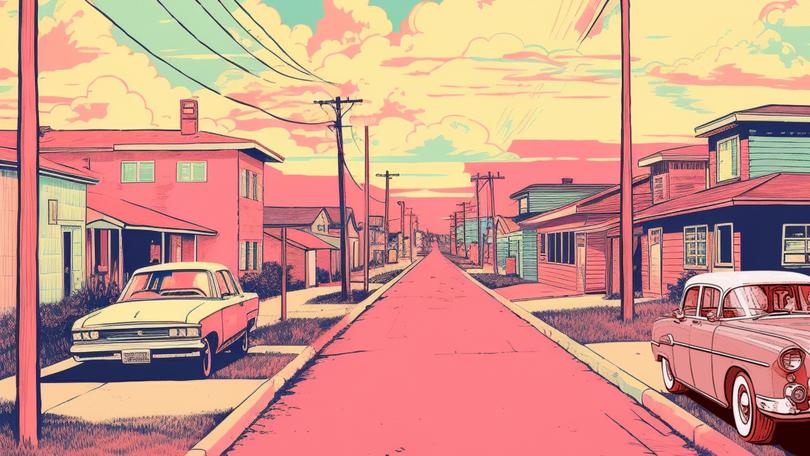Great Australian Plight Part Three: How the dream of owning a home has turned into a delusion for young people

The Australian dream of home ownership is increasingly becoming a delusion for those without the advantage of family money, with generations now facing a lifetime of renting as sky-high property prices outpace saving deposits.
In 2024 it takes a median income worker on average more than 10 years to save a 20 per cent home deposit, according to CoreLogic, a task which is unlikely to be helped by the recent cost of living crisis and rising inflation.
The ratio of house values to income is now 8.3 nationally and 11.3 in Sydney.
Sign up to The Nightly's newsletters.
Get the first look at the digital newspaper, curated daily stories and breaking headlines delivered to your inbox.
By continuing you agree to our Terms and Privacy Policy.Australian Housing and Urban Research Institute managing director Michael Fotheringham said the nation had plodded towards the current housing predicament for decades but the pandemic supercharged existing pressures on the system.
“The perfect storm of the pandemic and its effect on housing systems continues to reverberate throughout our housing supply now at a time when re-homing costs have gone up and up,” he said.
“There’s a whole lot of metrics you can use to describe our housing system.
“You can look at the declining rate of home ownership by every age group.
“You can look at the vacancy rates in the rental market, you can look at the proportion of housing that is social and affordable housing. You can look at matters of what proportion of housing is available to someone on a median income, it’s an increasingly small number.
“There is a range of metrics you can use. But what is clear is that our housing is increasingly unaffordable and it’s going to take quite some time to build our way out of the problem.”
Generation Z, a cohort born between 1997 and 2012, is facing a property market that has become completely inaccessible since prices started to rise at the end of the pandemic.
House prices surged 8.3 per cent in 2023, according to CoreLogic, including 15.2 per cent in Perth, 13.1 per cent in Brisbane and 11.1 per cent in Sydney due to supply shortages, construction delays and population growth driven by overseas migration.
Stimulatory policies intending to offset the downturn of the pandemic, including the First Home Loan Deposit Scheme and the Home Builders Scheme, unleashed latent demand that turbocharged home and rental prices.
CoreLogic head of research Eliza Owen said it allowed a lot of Millennials to leapfrog the deposit hurdle and enter the market sooner, which she said would likely change the politics around housing.
“All of a sudden you do have a bunch of Millennials who have skin in the game if you like,” she said.
“But I think broadly speaking even with that concentrated period of first home buyer activity, we’ll probably continue to see high rates of home ownership decline.
“Just because home values will continue to outpace income growth in the long term.”

Rates of homeownership among those born between 1947 and 1951, also known as Baby Boomers, increased from 54 per cent in 1976 to 82 per cent in 2021, according to the Australian Institute of Health and Welfare.
However, rates of home ownership have more or less fallen for every other demographic. About 64 per cent of 30-34-year-olds owned a home in 1971, falling to 50 per cent in 2021.
Emma Musica, 68, bought her house on an acreage in Luddenham in Sydney’s far west about 35 years ago.
Her kids and her grandkids have grown up knowing her house is their home. Now Ms Musica says her older grandchildren, 25 and 22, are struggling to scrape together a deposit to buy an investment property as they can’t afford to buy a home.
“They [grandchildren] are finding it hard, they’re trying desperately to save to buy something at the moment - I don’t think they can do it without a little bit of help.
“They’ll probably buy something small to invest in for now. Not to live, they’re living at home at the moment.
“I think a lot of young people have that problem. They could scrape together a deposit but they have to pay the loan. It would have to be an investment property to help you pay, it might be a few more years before you can have your own home.”
The origins of the current housing crisis started decades ago and successive governments have largely ignored the increasingly difficult task of fixing the sector.
University of Sydney senior lecturer Laurence Troy, who specialises in urban research, said the government was building about one in four houses in the postwar period, allowing administrations greater control over the price of homes and land values.
Mr Troy said, that under former Liberal Prime Minister Robert Menzies, who held the job from 1949 to 1966, housing policy shifted from public housing to supporting home ownership.
“This nexus between full-time waged employment and mortgaged home ownership was really critical through that postwar period and driven by Menzies in particular,” he said.
The next big change to home ownership in Australia was the process of economic deregulation undertaken by former Labor Prime Ministers Bob Hawke and Paul Keating in the 1980s and 1990s.
This period of market liberalisation, which heralded unprecedented economic growth in Australia, made it harder for workers to save for the deposits necessary to obtain a mortgage.
But the market really started to take off after the Howard government introduced the capital gains tax discount in 1999, which supercharged the then-underappreciated policy of negative gearing.
Mr Troy said the tax double whammy opened the housing market’s floodgates to money and investors, pushing the value of property away from the wages earned by workers.
“As more money came in, property prices started to go up and it enabled people who were already sitting on housing to then go back and extract some of that capital gain, re-mortgage their house, extract some of the value of it, then you can go back to the bank and borrow more money to invest in housing,” he says.
“It kind of then cycles on as they invest more money.”
About 6 per cent of 8.2 million tax filers in the 1985-86 financial year reported rental income, according to Australian Tax Office data, compared to the 15 per cent of 15.1 million tax filers in the 2020 and 2021 financial year.
The woman tasked with making housing affordable again, National Housing Supply and Affordability Council chair Susan Lloyd-Hurwitz, said it would be decades before there were any tangible improvements.
“I think we’re in a difficult position in that our housing system isn’t functioning at all well,” she said.
“This is fundamentally a question of supply and we need as a country to focus on all the things that impede supply when it comes to bringing houses onto the market to meet the demand that we have.”
When 21-year-old Inke Bester is asked if she still hopes to buy a home in Sydney, she says “It’s really hard to imagine.”
Both Ms Bester and her sister Mel Bester, 26, live in shared houses in Sydney’s inner west.
Like many others, they are battling rising rents, indomitable mould and indifferent landlords.
But given soaring rents and the low supply of rentals, the Bester sisters consider themselves lucky to have rooms to rent.
“We feel like we have no power to push back against anything because at any moment they can just tell you, oh well if you’re unhappy living here you can just leave and someone else will just come in,” Inke Bester said.
She told The Nightly that she had been saving to buy a home but that the dream was well and truly dead.
“I’ve just kind of almost accepted it probably won’t happen and it especially won’t happen here (Sydney),” she said.

